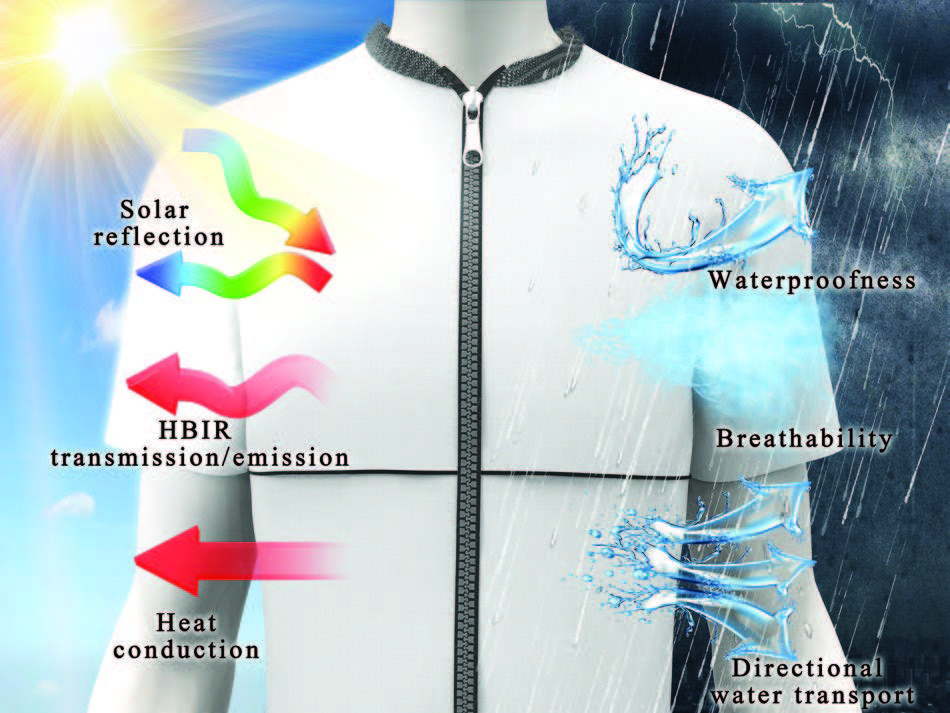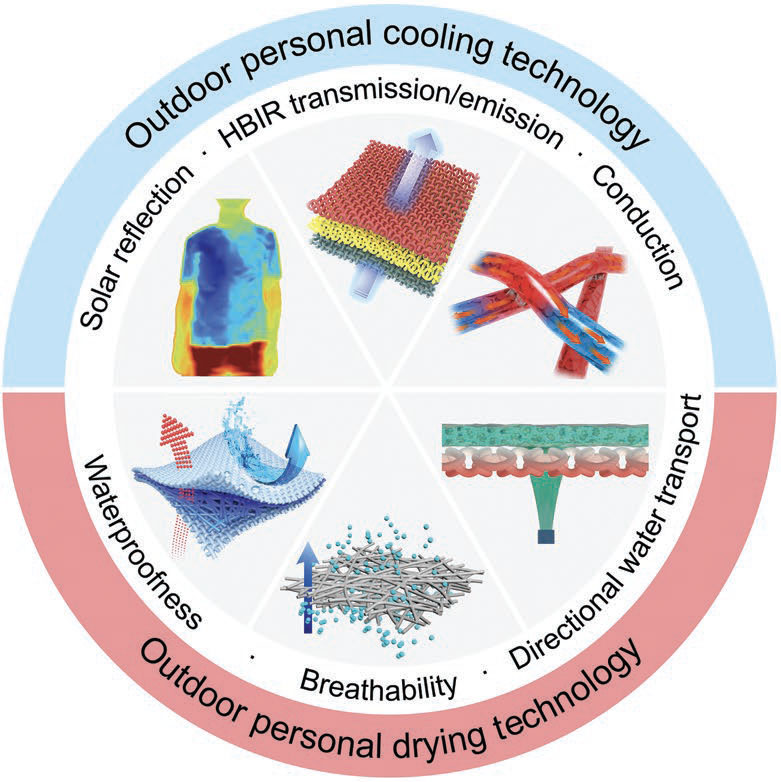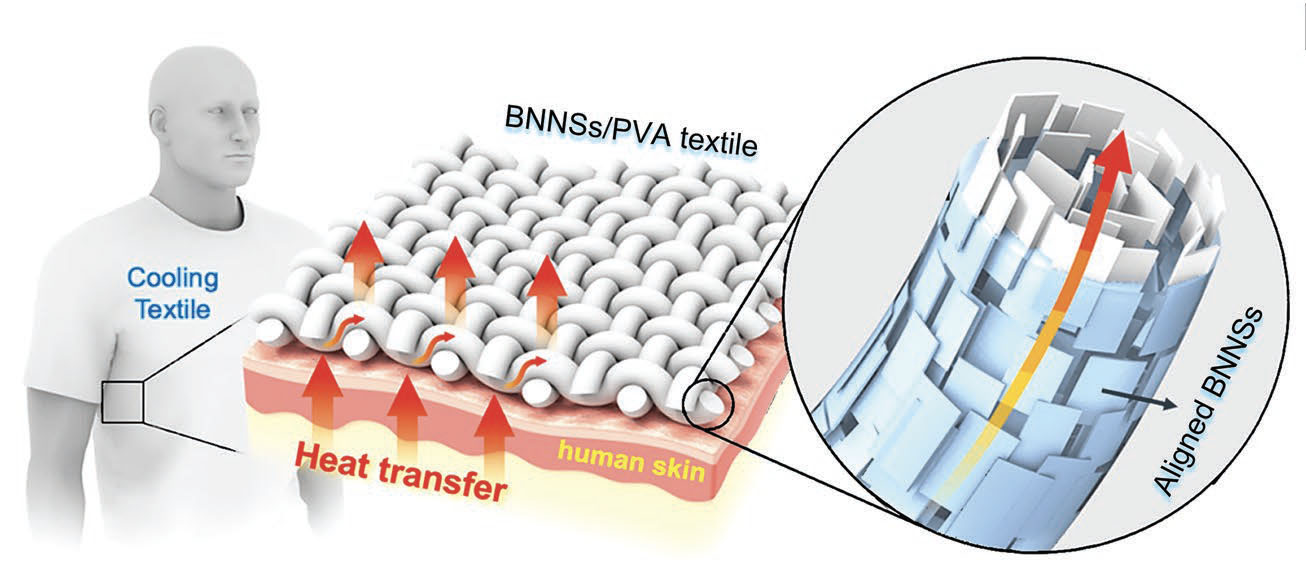| Mar 06, 2023 |
|
|
|
(Nanowerk Spotlight) The outdoor environment has become an indispensable aspect of our daily lives, serving as a venue for a plethora of activities, including recreation, sports, and leisure, as well as work-related endeavors. However, the increasingly frequent extreme weather events caused by climate change have made personal comfort in outdoor spaces a critical consideration for human health and sustainable development.
|
|
During outdoor physical activity , the human body acts as an internal heat source, exchanging heat and sweat with the surrounding environment through textiles, which serve as the second skin. Personal comfort involves three stages: precise regulation of the microenvironment between the skin and textiles; the internal section of the textiles; and the macroenvironment between the textiles and the ambient environment.
|
|
Generally, there exist four primary avenues for achieving personal cooling and drying: radiation, conduction, convection, and sweat evaporation. These four pathways work in tandem to bring about optimal personal comfort in real-world situations, albeit with varying degrees of significance depending on the prevailing outdoor environmental conditions.
|
 |
| Personal cooling and drying in outdoor sunny or rainy environments. Advanced functional textiles offer personal thermal and moisture comfort through various pathways, such as solar reflection, HBIR emission / transmission, heat conduction, waterproofness, breathability, and directional water transport. (Reprinted with permission from Wiley-VCH Verlag)
|
|
The human body’s most fundamental physiological defense against overheating during physical exertion in hot outdoor environments is the evaporation of sweat. However, two substantial challenges must be contended with to achieve optimal personal cooling and drying in outdoor settings: the heat input from exposure to sunlight and the intrusion of rainwater.
|
|
Addressing these challenges necessitates the development of advanced functional textiles capable of reflecting solar radiation, facilitating heat dissipation, and resisting water intrusion, while still permitting the crucial process of sweat evaporation to take place.
|
|
The intricate process of personal cooling and drying involves the interrelated release and absorption of sweat by the textile, resulting in evaporative cooling and heat generation, respectively. The design of advanced functional textiles for this purpose demands careful consideration of their thermal, optical, structural, and specialized wetting properties. Unlike conventional cooling methods, these textiles provide localized management of body thermal and moisture levels, without the need for excessive energy consumption to cool and dry the entire indoor living space.
|
 |
| Advanced functional textiles developed for personal thermal and moisture comfort in both research and industry. (Reprinted with permission from Wiley-VCH Verlag)
|
|
Functional textiles also enhance human comfort in outdoor activities that require cooling, warming, or drying, resulting in improved comfort levels and increased productivity in outdoor work.
|
|
Furthermore, there is the potential for functional textiles to be integrated with IoT devices for a range of applications, including healthcare, sports, and fashion, demonstrating how nanotechnology can be used to create smart textiles that can provide real-time data on various metrics.
|
|
The integration of advanced functional textiles with nanotechnology is currently underway to provide better personal cooling and drying performance in outdoor environments, endowing textiles with various high-quality functions.
|
|
There are many examples of this has been achieved in various ways. For example, infrared radiation is a primary way the body releases heat and is the focus of a novel textile technology for a fabric that can automatically regulate the amount of heat that passes through it depending on conditions. For example, when conditions are warm and moist, such as those of a sweating body on a summer day, the fabric allows infrared radiation (radiant heat) to pass through. When conditions become cooler and drier, the fabric reduces the heat that escapes. Infrared radiation is a primary way the body releases heat and is the focus of this new technology.
|
|
researchers have demonstrated smart fabrics that generate electricity and support temperature regulation through cooling. It is now also possible to fabricate omniphobic textiles (which are repellent to oils, water, and dust) that can protect you from rain, stains, and bacteria, while they harvest the biomechanical energy of the user to power textile-based electronics.
|
|
In yet another example, researchers have have spun recycled polyethylene into fibers and yarns designed to wick away moisture. Woven into silky, lightweight fabrics the yarns absorb and evaporate water more quickly than common textiles such as cotton, nylon, and polyester.
|
|
A recent review article in Advanced Functional Materials (“Nanoengineered Textiles for Outdoor Personal Cooling and Drying”) discusses recent advancements in the development of nanoengineered textiles for outdoor personal cooling and drying.
|
|
The article also provides insights into the mechanisms of heat dissipation and water transport, which work synergistically to create a comfortable microenvironment for the human body.
|
|
While there are still gaps in practical applications, this review highlights the potential for these textiles to improve outdoor living quality and labor productivity while satisfying increasing demands for health, safety, and sustainability.
|
|
In general, nanoengineering techniques can be used to enhance the functionality of textiles, such as thermal conductivity, optical scattering, special wettability, antibacterial properties, and electrical conductivity.
|
|
Textile researchers and industry use three primary methods to create nanoengineered textiles with nanoporous, nanofibrous, and nanocomposite structures, which are discussed in detail in the review:
|
|
The first method involves adding nanoporous functional layers to traditional textiles using nanoporous coating and laminating, which are simple processes that preserve textile strength.
The second method is nanofiber spinning, a scalable and straightforward manufacturing technique that produces nanofibrous textiles with customizable fiber structures and functionality.
Finally, nanocomposite coating and embedding are used to prepare nanocomposite textiles by introducing nanomaterials onto the fiber surface or into the fibers themselves. In this case, the textile’s performance depends on the introduced nanomaterials, such as functional nanoparticles, nanotubes, and nanosheets.
|
|
The authors proceed to delve into detailed discussions concerning nanoengineered textiles designed for two specific outdoor purposes: personal cooling and personal drying. Each topic is dedicated its own thorough section.
|
Personal cooling
|
|
The human body regulates its temperature through various processes such as sweating and dilating skin capillaries. However, in extreme weather conditions or intense exercise, it becomes difficult for the body to maintain its thermal balance. Nanoengineered textiles have been developed as an external method of regulating body temperature by dissipating accumulated heat without consuming external energy. This section provides a systematic review of the mechanisms of heat dissipation in nanoengineered textiles and how they are prepared.
|
|
Radiative cooling textiles with spectral selectivity: Developing outdoor clothing that keeps you cool by reflecting sunlight and radiating body heat is a challenge for designers. This requires creating materials that reflect sunlight well but also allow the body to release heat to the environment. To achieve this, the clothing needs to have high reflectance in the solar region (0.3-2.5 µm) but allow for high transmittance and emittance in the body’s heat infrared (HBIR) region (7-14 µm). This design is challenging because it requires fine-tuning the material’s optical properties across a wide range of wavelengths.
|
Conductive cooling textiles with high thermal conductivity: The layer of fabric that touches our skin affects how efficiently our clothes can cool us down. Traditional fabrics like cotton, wool, PET, and nylon have low thermal conductivity, which means they’re not very effective at dissipating heat when our body temperature increases. This can make us feel hot and uncomfortable. To improve this, researchers have added thermally conductive fibers like boron
nitride nanosheets, carbon nanotubes, and graphene to fabrics. These fibers have high thermal conductivity and can help dissipate heat more effectively, which can make us feel cooler and more comfortable.
|
 |
| Nanoengineered textiles with enhanced thermal conductivity for outdoor personal conductive cooling. Shown here is the heat dissipation process of a thermally conductive BNNSs/PVA textile for personal cooling. (Reprinted with permission from Wiley-VCH Verlag)
|
Personal drying
|
|
Outdoor personal drying refers to how our bodies get rid of sweat and water vapor efficiently to maintain comfort when we’re sweating. When our body temperature goes up, we sweat to cool ourselves down. If it’s raining outside, it’s harder for the sweat to evaporate and we might feel uncomfortable. But if it’s sunny, we might sweat more than our body can handle, making us feel uncomfortable as well.
|
|
Scientists are looking at how plants and animals repel water to help them design new fabrics that help us sweat and evaporate water better. These biomimetic special wettabilities provides researchers with nature-inspired solutions for the functional design of nanoengineered textiles. The most famous are the superhydrophobic lotus leaf effect with a self-cleaning property and the superhydrophobic legs of water striders that are covered with microscale bristles that allow them to stand and walk freely on water surfaces.
|
|
Some biological surfaces, such as those found on beetles, cacti, spider silk, and bird beaks, have unique micro and nanoscale structures that allow them to transport water in a specific direction. These structures include anisotropic wettability, curvature gradient, and surface energy gradients. These organisms have evolved these structures to survive in harsh environments, such as deserts, and they can collect water droplets from fog or capture water using a capillary ratchet mechanism. These examples from nature could inspire the development of new materials with directional water transport capabilities.
|
|
What researchers have learned from this is that, when designing materials that are inspired by nature and have unique water-repelling or water-attracting properties, it’s important to consider both the material’s properties and its micro and nanostructures. There are two main ways to do this: by creating structures that are hierarchical (meaning they have different levels of organization), which can make the material more effective at repelling or attracting water, and by arranging the structures in a way that causes water to move in a particular direction.
|
The authors then go on to describe examples of waterproof and breathable textiles with
superhydrophobicity and directional water transport textiles with wettability gradient. Finally, they describe examples of biomimetic transpiration textiles that were designed to realize synergistic personal cooling and drying.
|
|
For instance, one example of a biomimetic transpiration textile for highly efficient personal drying and cooling is based on the hierarchical and interconnected network of vascular plants. The researchers found that the underlying mechanisms of transpiration in vascular plants and water transport in nanoengineered textiles are the same.
|
|
Specifically, the way plants release water from their leaves and the way nanoengineered fabrics can draw sweat away from our skin are actually quite similar. Both use a system of nanoscale tubes or fibers to move water from one place to another. Plants use this system to pump water and nutrients up from the ground and cool themselves down by releasing water from their leaves. Nanoengineered fabrics use a similar system to move sweat away from our skin and help us stay dry and cool.
|
|
In concluding their review, the authors point out four aspects of nanoengineered textiles that they suggest need to be further explored to promote their development toward practical applications.
|
|
Nanomaterial safety
|
|
Nanoengineered textiles that have great potential for outdoor cooling and drying potentially also raise concerns about human health risks and environmental impacts. Different methods of incorporating nanoparticles into textiles have been tried, but most suffer from poor adhesion or durability. Embedding nanoparticles into synthetic fibers during spinning can create a stable material, but direct-spinning technologies need reinforcement with traditional fabrics. A careful assessment of the benefits, risks, and life cycle of nanoengineered textiles is needed before they can be used practically.
|
|
Basic mechanisms
|
|
The exchange of heat and sweat through textiles that act as a second skin to connect the body to the environment is complex and intertwined. Therefore, nanoengineered textiles for outdoor cooling and drying need to be carefully designed based on a comprehensive understanding of the human body, microenvironment, textiles, and ambient macroenvironment. To optimize material selection and structural design, a microstructure model of heat and sweat exchange through textiles is needed to clarify the synergistic thermal and moisture management mechanism under various environmental conditions.
|
|
Evaluation standards
|
|
Scientists and engineers have developed various nanoengineered textiles for outdoor cooling and drying applications, and have evaluated their thermal and moisture management performance using different tests. However, it’s unclear whether these performance parameters are effective for practical applications. Also, there’s no universally adopted test standard for demonstrating the outdoor cooling and drying effects of nanoengineered textiles.
|
|
In practical application, the most direct evaluation standard is personalized comfort, which includes subjective opinions. Therefore, more tests involving personal experiences, such as breathing, sweating, and thermal manikin tests, should be widely used.
|
|
Smart thermal and moisture management systems
|
|
Scientists are developing smart textiles that use Internet of Things technologies, nanogenerators, sensors, solar cells, supercapacitors, and other flexible electronics to improve personal cooling and drying. These advanced textiles can collect real-time data from the microenvironment and macroenvironment, analyze it, and use it to regulate heat and sweat exchange according to personalized thermal and moisture comfort requirements in outdoor environments.
|
|
This technology can act as an intelligent platform to automatically improve personal comfort. The goal is to connect human physiology and psychological activities with smart textiles, making personal cooling and drying more efficient and effective. This technology represents a future direction for the next-generation of advanced textiles.
|
By
Michael
Berger
–
Michael is author of three books by the Royal Society of Chemistry:
Nano-Society: Pushing the Boundaries of Technology,
Nanotechnology: The Future is Tiny, and
Nanoengineering: The Skills and Tools Making Technology Invisible
Copyright ©
Nanowerk
|
Become a Spotlight guest author! Join our large and growing group of guest contributors. Have you just published a scientific paper or have other exciting developments to share with the nanotechnology community? Here is how to publish on nanowerk.com.
|



